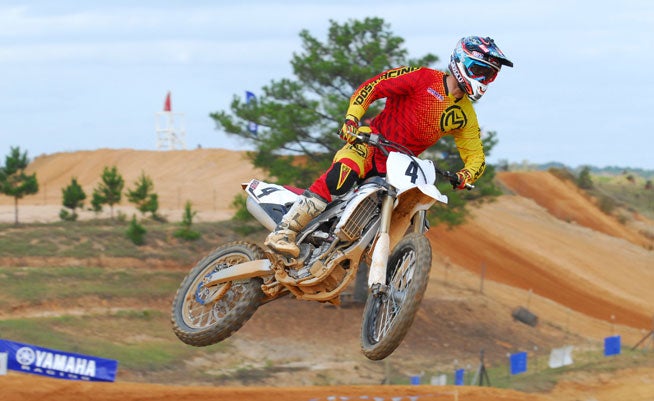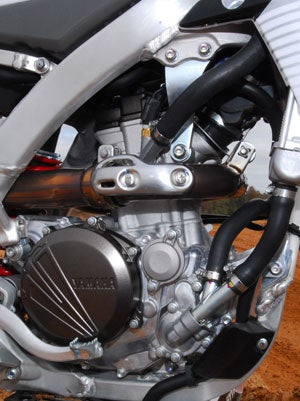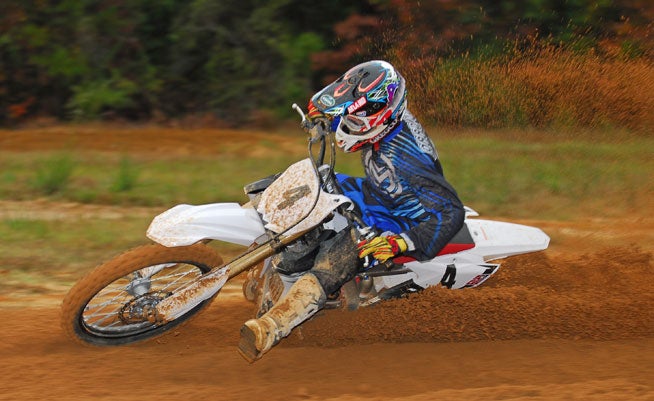Yamaha’s all-new 250 packs a mighty mid-range punch that may knock out the competition in this year’s 250cc motocross title fight

Just a few hours aboard a pre-production unit earlier this summer convinced us that the 2014 Yamaha YZ250F might be something special. Now, with two more full days of testing under our belt at the picturesque Monster Mountain MX Park near Montgomery, Alabama, we know it is.
Engine

The Monster Mountain facility features a main track that features a lot of step-up style double and triple jumps. These obstacles placed a premium on mid-range oomph since many of them required third or fourth gear in order to clear them but did not mandate strangling every last rev out of the motor. Thus, throttle response and mid-range performance were a key to fast lap times, and the YZ250F’s new reverse-incline engine possessed both the lightning-quick throttle response and abundant mid-range punch for Expert test rider Ryan Abbatoye to pop over any jump on the track with total confidence.
But there’s more going on with the new YZ250F motor than just a mere alteration of the powerband. The engine itself is so much stronger than any stock 250cc four-stroke we’ve encountered that it was almost hard to believe that it only displaces 249cc. In fact, Yamaha officials claim that the new engine makes 40 horsepower at the rear wheel. By way of comparison, that game-changing YZ400F of 15 years ago made about 45!
The 2014 YZ250F’s 77.0 x 53.6mm bore and stroke and 13.5:1 compression ratio are the same as the 2013’s, but the greater power production comes primarily from three key areas. The first is the new Keihin 44mm throttle body, which utilizes a 10-hole injector fed by a battery-less electric fuel pump. Yamaha experimented with both 4-hole and a 12-hole injectors early in the 250F’s development before settling on the 10-holer because it delivered the overall power character its engineers were after. The 3D-mapped system collects its data from multiple sensors, reading throttle position, intake pressure, intake air temperature, crankshaft rpm and even the coolant temperature to signal the ECU to adjust the fuel mixture. The net result is tremendous throttle response at any rpm and under any engine load. Still, as good as the new EFI is, we were slightly miffed that the YZ often failed to start on the first kick and sometimes required three or four healthy boots to fire it up when the engine was warm.
The second major improvement lies in the general architecture of the reverse-inclined engine itself. In addition to centralizing mass in the chassis, the engine’s design, which moves the cylinder from a 10.5-degree forward cant to 6.2 degrees rearward. This 16.7-degree change may not sound like much, but it effectively places the cylinder in a more vertical position while moving it 2 inches toward the center of the motorcycle. And, combined with a 3.5mm cylinder offset toward the crankshaft, it greatly reduces internal friction by placing the connecting rod in a more vertical position at the moment of greatest combustion force. This reduces sidewall friction, which in turn is reduced even further via an all-new piston that is 2.2mm shorter, 13 grams lighter and also uses a single ring design.
The third major key lies in the revamping of the YZ’s reverse-mounted DOHC cylinder head. The new downdraft design, which places the air filter right behind the steering head, allows the intake charge a 30-degree straighter shot into the combustion chamber, and its symmetrical ports increase velocity while reducing turbulence for better cylinder filling. The new four-valve head also carries one less intake valve, utilizing titanium valves that measure 31mm on the intake side and 25mm on the exhaust. The valve angle is also a much narrower 23.7 degrees compared to 30.5 degrees on the old motor.

The reward for all of Yamaha’s hard work is an engine that produces mind-boggling power for its displacement size. It’s an overachiever in the mid-range and a strong contender up top, but what really surprised us at Monster Mountain was just how much low-end torque is available as well. During day two of our test, rain forced a delay in riding the main track, so we spent much our time riding the shorter “vintage track,” which is composed of European-style deep sand. The YZ250F’s ability to churn out of low-speed corners in third gear without major clutch abuse was impressive indeed.
The 250F’s broad torque doesn’t require nearly as many shifts per lap to keep the motor singing, but that extra oomph did require stronger third and fourth gearsets as well as fitting the clutch with a stouter pressure plate to handle the extra load placed on its five-speed transmission. Additionally, Yamaha engineers focused on improving the 250F’s shift by installing new shift forks, redesigning the shift bars by making them float on springs to reduce binding and fitting the shifting mechanism with a bearing to reduce friction. The shift lever and shift shaft are also new. With more time aboard the bike, our take is that the clutch action is excellent and the overall shift quality very good, although some of our less experienced testers still complained of an occasional missed shift.
 Your Privacy Choices
Your Privacy Choices